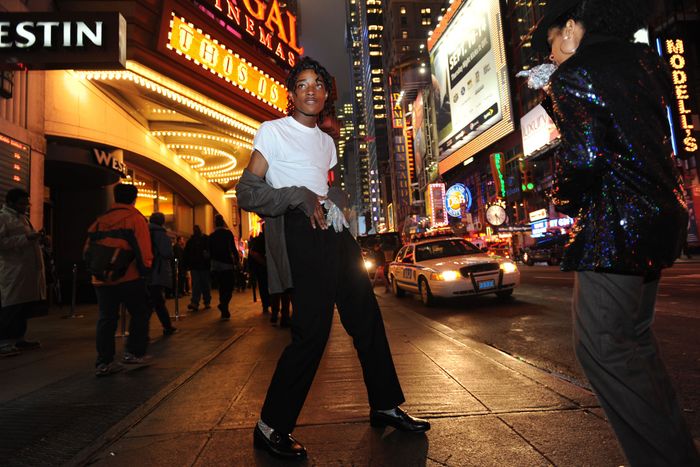
At one time in New York City, if you wanted to see Michael Jackson, you looked for Jordan Neely. Even among the performers in Times Square, who get every high-pitched “ee-hee” right and moonwalk seamlessly, Neely was exceptional. “He’s actually famous here,” YouTuber and Jackson fan Gadget Trish said about Neely on May 3, two days after he was killed by another passenger on the F train. Moses Harper called him more than an impersonator — he was a “tribute artist.”
In the wake of Neely’s murder on May 1, the community of Michael Jackson impersonators and fans, who call themselves a “fanmily,” is mourning the loss of one of their own. The person they saw referred to in the press as an “aggressive homeless man” with an arrest record was a talented friend and fellow performer. Brenna Crowley, who knew Neely, wrote on Facebook that it had been years since she’d seen him, “but I was always in awe seeing him dance when I did.” He had something special.
Also on Facebook, Harper recounted first meeting a “kind-hearted, sweet” Neely in 2009 as a wunderkind teenager performing as Jackson in Times Square. He was just 16 and didn’t even have a costume yet, but she was struck by his genuine interactions with the crowd and his obvious love for performing. “The tourists, they adored him,” she said. Neely asked Harper, a fellow tribute artist, for dance tips, and honed his craft over the next few years, eventually buying a jacket with epaulets and mastering the full look. “He became known,” Harper said. “I loved watching it.”
Lance Clarke, an attorney, first saw Neely perform as Jackson at a family member’s birthday party ten years ago. Neely “was the guy,” he told me over the phone. “The kids thought he really was Michael.” Over the years, Clarke said he frequently saw Neely performing on the A train, but he appeared to be going through progressively harder times. “First he was performing with the costume, then the costume got tattered,” he said. “Then no costume. Then he couldn’t do the moves, the kicks. Then no performing at all.” A few years ago, Clarke brought Neely home with him and gave him some food and a few bags of clothes. “He put his soul into performing and after a few years on the street, he had no soul left,” Clarke says. “He was just begging for help.”
It also would have been hard for him to make a living as a subway performer, according to TT, the manager and backup dancer for another MJ impersonator named “Michael’s Mirror.” “Full-time MJ impersonators mostly do the Vegas circuit and shows like Legends in Concert,” she told me. “But Jordan never seemed to know how good he was. I guess that he performed in the subway and streets just because he loved it so much.”
Relatives of Neely’s have said that he suffered from severe mental-health issues stemming from the loss of his mother, who was killed by Neely’s stepfather in 2007, when Neely was only 14. They described his condition worsening over the last several years — particularly the last two, according to one close family friend. Harper said on Facebook that she had also seen Neely struggling. When she last saw him in 2016, “he tried to put his head down and walk past me and I said, ‘No, no, no.’ ‘You’re getting off at the next stop with me.’” She lost track of him after that. But people in the MJ community kept searching. TT said she was looking for Neely in the last few months, hoping he might perform at a June tribute to Jackson. “It wasn’t just me, there were a lot of us who were looking for him,” Harper said. “It’s tragic that this is how we found him.”





